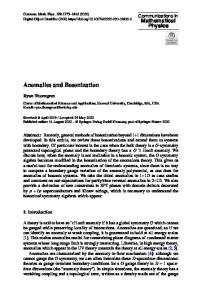Circulation and Climatic Anomalies
The Arctic is warming two to four times faster than the global average and the Arctic sea ice has undergone a substantial long-term decline with superimposed interannual sea ice minimum (SIM) events over the past decade. Eurasian and tropical climatic eve
- PDF / 86,431,395 Bytes
- 697 Pages / 453.543 x 683.15 pts Page_size
- 39 Downloads / 292 Views
Weihong Qian
Temporal Climatology and Anomalous Weather Analysis
Springer Atmospheric Sciences
More information about this series at http://www.springer.com/series/10176
Weihong Qian
Temporal Climatology and Anomalous Weather Analysis
123
Weihong Qian Department of Atmospheric and Oceanic Sciences School of Physics, Peking University Beijing China
ISSN 2194-5217 Springer Atmospheric Sciences ISBN 978-981-10-3640-8 DOI 10.1007/978-981-10-3641-5
ISSN 2194-5225
(electronic)
ISBN 978-981-10-3641-5
(eBook)
Library of Congress Control Number: 2016963420 © Springer Nature Singapore Pte Ltd. 2017 This work is subject to copyright. All rights are reserved by the Publisher, whether the whole or part of the material is concerned, specifically the rights of translation, reprinting, reuse of illustrations, recitation, broadcasting, reproduction on microfilms or in any other physical way, and transmission or information storage and retrieval, electronic adaptation, computer software, or by similar or dissimilar methodology now known or hereafter developed. The use of general descriptive names, registered names, trademarks, service marks, etc. in this publication does not imply, even in the absence of a specific statement, that such names are exempt from the relevant protective laws and regulations and therefore free for general use. The publisher, the authors and the editors are safe to assume that the advice and information in this book are believed to be true and accurate at the date of publication. Neither the publisher nor the authors or the editors give a warranty, express or implied, with respect to the material contained herein or for any errors or omissions that may have been made. The publisher remains neutral with regard to jurisdictional claims in published maps and institutional affiliations. Printed on acid-free paper This Springer imprint is published by Springer Nature The registered company is Springer Nature Singapore Pte Ltd. The registered company address is: 152 Beach Road, #21-01/04 Gateway East, Singapore 189721, Singapore
Preface
Weather extremes such as heat waves, cold surges, heavy rains, severe drought and forest wildfire, unusual storm tracks, and tornadoes frequently hit humankind. Climatic anomalies like the Arctic warming and sea ice decline have become a hot topic of climate change in recent years. Can we find early signals or methods to predict these weather extremes? And how can we explain these climatic anomalies? Some questions have been raised by meteorological researchers and weather forecasters. Since more data from satellite observations and mathematical model simulations have become accessible, we feel that atmospheric motion is more complex and full of chaos. We worry about if we are still standing on a mound while more data are filled like a high mountain. We need to stand on a higher platform to inspect the general circulation and anomalous atmospheric motion. Finally, we can physically achieve to build a connection between the surface weather extremes and atmospheric vari











